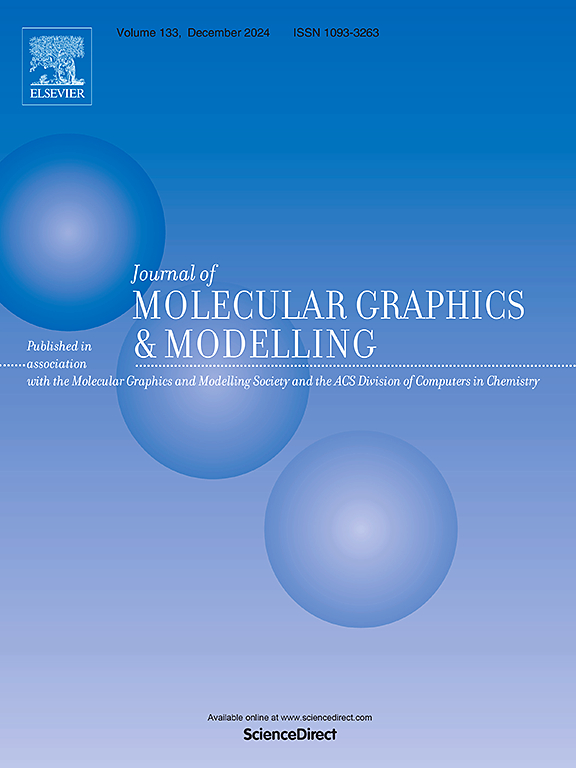揭示2-苯基噻吩推拉发色团中的电荷转移动力学和静动态非线性光开关:基于dft的增强谐波产生和电光应用的理论建模
IF 3
4区 生物学
Q2 BIOCHEMICAL RESEARCH METHODS
引用次数: 0
摘要
针对超快光子非线性光学(NLO)材料日益增长的需求,利用532和1064 nm激光脉冲,详细研究了2-苯基噻吩基推挽发色团的超快开关NLO行为。对这些激光脉冲的EOPE β(−ω, ω, 0)和SHG β(−2ω, ω, ω)计算显示出令人难以置信的NLO响应,其有效的能量偏移量约为BSS-1的6倍。此外,还分析了实验和理论偶极矩与紫外吸收(λ(exp) = 397, λmax = 394.94 nm)之间的相关性,强调了其对NLO开关器件开发的影响。通过前沿分子轨道(FMOs)、UV-Vis研究、电子-空孔重叠分析、非共价相互作用(NCI)、分子静电势(MEP)、自然键轨道(NBOs)以及静态和频率相关的NLO等量子化学计算来确定供体和受体修饰对设计的发色团(BSSR1-BSSR8和参考BSS-1)增强谐波产生的影响。值得注意的是,在硝基和氰基受体化合物中获得了突出的NLO发现。有趣的是,在所有衍生物中,BSSR4和BSSR5的Egap值最低,分别为1.09和1.246 eV, Egap值的递减顺序为:BSS-1 (R) >;BSSR1祝辞BSSR3祝辞BSSR7祝辞BSSR6祝辞BSSR2祝辞BSSR8祝辞BSSR5祝辞BSSR4。令人惊讶的是,BSSR5和BSSR4在气相的最大NLO (α和β)振幅分别为8.62 × 102和8.09 × 105 a.u,表明它们在全光计算和超高带宽信息处理方面的潜力。这些发现强调了2-苯基噻吩推拉发色团中电荷转移动力学和超快NLO开关的重要性,为先进的谐波产生和尖端的电光应用铺平了道路。本文章由计算机程序翻译,如有差异,请以英文原文为准。

Unveiling charge transfer kinetics and static-dynamic nonlinear optical switching in 2-phenylthiophene push-pull chromophores: DFT-based theoretical modelling for enhanced harmonic generation and electro-optic applications
Addressing the growing demand for ultrafast photonic nonlinear optical (NLO) materials, ultrafast switching NLO behaviour was studied in detail in 2-phenylthiophene-based push-pull chromophores using laser pulses at 532 and 1064 nm. The EOPE β (−ω, ω, 0) and SHG β (−2ω, ω, ω) calculations for these laser pulses demonstrate an incredible NLO response with efficient energetic offsets that are approximately six times larger than BSS-1. Moreover, the correlation between experimental and theoretical dipole moments and UV absorption (λ(exp) = 397, λmax = 394.94 nm) is analyzed, emphasizing its impact on developing NLO switching devices. Quantum chemical calculations, such as frontier molecular orbitals (FMOs), UV–Vis investigation, electron-hole overlap analysis, non-covalent interaction (NCI), molecular electrostatic potential (MEP), natural bond orbitals (NBOs), along with static and frequency-dependent NLO were performed to determine the effect of donor and acceptor modification on the enhanced harmonic generation of designed chromophores (BSSR1-BSSR8 and reference BSS-1). Notably, outstanding NLO findings were obtained for nitro and cyano-based acceptor compounds. Interestingly, among all the derivatives, BSSR4 and BSSR5 had the lowest Egap values of 1.09 and 1.246 eV, respectively, and the Egap values were found in the following decreasing order: BSS-1 (R) > BSSR1 > BSSR3 > BSSR7 > BSSR6 > BSSR2 > BSSR8 > BSSR5 > BSSR4. Surprisingly, BSSR5 and BSSR4 had maximum NLO (α and β) amplitudes of 8.62 × 102 and 8.09 × 105 a.u in the gas phase, respectively, indicating their potential towards all-optical computing and ultrahigh bandwidth information processing. These findings underscore the significance of charge transfer dynamics and ultrafast NLO switching in 2-phenylthiophene push-pull chromophores, paving the way for advanced harmonic generation and cutting-edge electro-optic applications.
求助全文
通过发布文献求助,成功后即可免费获取论文全文。
去求助
来源期刊

Journal of molecular graphics & modelling
生物-计算机:跨学科应用
CiteScore
5.50
自引率
6.90%
发文量
216
审稿时长
35 days
期刊介绍:
The Journal of Molecular Graphics and Modelling is devoted to the publication of papers on the uses of computers in theoretical investigations of molecular structure, function, interaction, and design. The scope of the journal includes all aspects of molecular modeling and computational chemistry, including, for instance, the study of molecular shape and properties, molecular simulations, protein and polymer engineering, drug design, materials design, structure-activity and structure-property relationships, database mining, and compound library design.
As a primary research journal, JMGM seeks to bring new knowledge to the attention of our readers. As such, submissions to the journal need to not only report results, but must draw conclusions and explore implications of the work presented. Authors are strongly encouraged to bear this in mind when preparing manuscripts. Routine applications of standard modelling approaches, providing only very limited new scientific insight, will not meet our criteria for publication. Reproducibility of reported calculations is an important issue. Wherever possible, we urge authors to enhance their papers with Supplementary Data, for example, in QSAR studies machine-readable versions of molecular datasets or in the development of new force-field parameters versions of the topology and force field parameter files. Routine applications of existing methods that do not lead to genuinely new insight will not be considered.
 求助内容:
求助内容: 应助结果提醒方式:
应助结果提醒方式:


